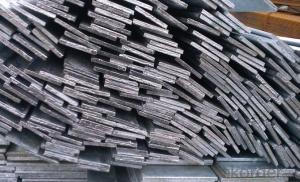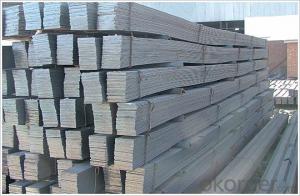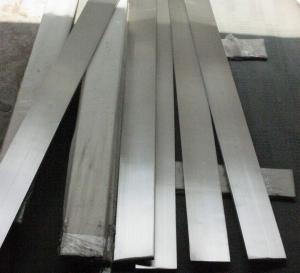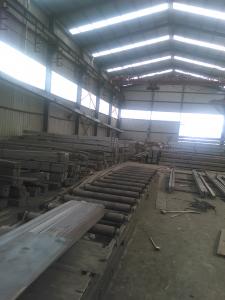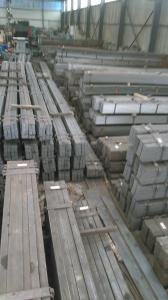Carbon Steel Flat Bar Cold Drawn Made in China for Sale
- Loading Port:
- China main port
- Payment Terms:
- TT or LC
- Min Order Qty:
- 50 m.t.
- Supply Capability:
- 10000 m.t./month
OKorder Service Pledge
OKorder Financial Service
You Might Also Like
Specifications of Steel Round Bar Cold Drawn with High Qaulity for Construction:
Commodity: Carbon Steel Flat Bar
Standard: GB, JIS, ASTM,
Material: Q235, SS400 or Equivalent
Brand name: FLATSPACE
Origin place: China
Thickness: 3mm-30mm
Width:20mm-200mm
Length: Max 12m
Certification: SGS/BV
Chemical composition
Alloy No | Grade | Element(%) | ||||
C
| Mn
| S
| P
| Si
| ||
Q235
|
B
|
0.12—0.20 |
0.3—0.7 |
≤0.045 |
≤0.045
|
≤0.3
|
Physical properties
Alloy No | Grade | Yielding strength point(Mpa) | Tensile strength (Mpa) | Elongation after fracture(%) | ||||||
Thickness (mm) | Thickness (mm) | |||||||||
≤16 | >16--40 | >40--60 | >60--100 | ≤16 | >16--40 | >40--60 | >60--100 | |||
≥ | ≥ | |||||||||
Q235 |
B |
235 |
225 |
215 |
205 |
375--500 |
26 |
25 |
24 |
23 |
Above sheets show the technical data of Q235,we can also provide other materials similar to Q235.
Applications of Steel Round Bar Cold Drawn with High Qaulity for Construction:
Widely used for construction;
Machinery manufacturing;
Iron tower steel structure;
Shipbuilding; Steel grating;
Staircase;
Bridge;
Viaduct;
Railway spare parts;
Boilers making etc.
Packaging & Delivery of Steel Round Bar Cold Drawn with High Qaulity for Construction:
Packaging Details: The Steel Flat Bars are packed in bundles and loaded in 20 feet/40 feet container, or shipped by bulk cargo ,also we can do as customer's requirements.
Delivery Details:30~45 days upon the receipt of buyer payment by T.T. or L/C.
Production Flow of Steel Round Bar Cold Drawn with High Qaulity for Construction:
The Carbon Steel Flat Bar is made through three processes:
1.Feeding the material: Feeding the row material (the steel plate) to Slitting Line.
2.Slitting:The steel plate would be slitted into expected width by lengthways cutter.
3. Leveled and cutting: The plat bar would be ground into level by the grinder and then cut into required length.
FAQ:
Q1: Why buy Materials & Equipment from OKorder.com?
A1: All products offered byOKorder.com are carefully selected from China's most reliable manufacturing enterprises. Through its ISO certifications, OKorder.com adheres to the highest standards and a commitment to supply chain safety and customer satisfaction.
Q2: How do we guarantee the quality of our products?
A2: We have established an advanced quality management system which conducts strict quality tests at every step, from raw materials to the final product. At the same time, we provide extensive follow-up service assurances as required.
Q3: How soon can we receive the product after purchase?
A3: Within three days of placing an order, we will begin production. The specific shipping date is dependent upon international and government factors, but is typically 7 to 10 workdays.
Images:
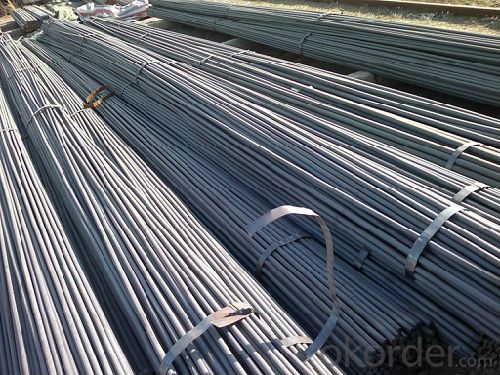
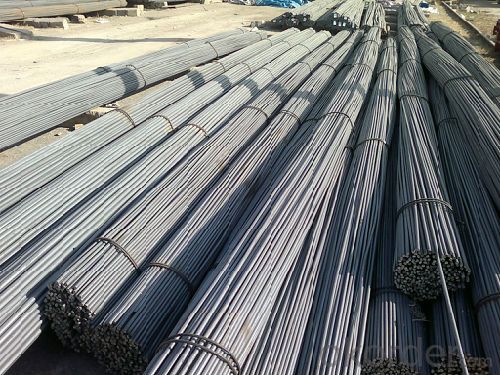
- Q:Can steel flat bars be used for making furniture frames or supports?
- Yes, steel flat bars can be used for making furniture frames or supports. They provide excellent strength and durability, making them suitable for bearing heavy loads and providing structural stability. Additionally, steel flat bars can be easily welded, bent, or shaped to meet specific design requirements, making them a versatile choice for furniture construction.
- Q:How do steel flat bars contribute to the strength and stability of structures?
- Steel flat bars contribute to the strength and stability of structures by providing structural support and reinforcement. Due to their high tensile strength and rigidity, steel flat bars are often used as load-bearing members in various construction projects. They help distribute and transfer the weight and forces acting on the structure, reducing the risk of deformation, bending, or collapse. Additionally, their flat shape allows for easy connection and welding, ensuring a secure and stable framework.
- Q:What is the thickness tolerance for steel flat bars?
- The thickness tolerance for steel flat bars varies depending on the specific manufacturing standards and requirements. Generally, the tolerance can range from +/- 0.005 to +/- 0.030 inches, but it is important to consult the specific standard or specification for accurate information.
- Q:How do steel flat bars contribute to the overall versatility of structures?
- The versatility of structures is enhanced by steel flat bars in several ways. Firstly, their flat and uniform shape allows for precise construction, making them easy to work with and manipulate. This versatility in shape and size enables steel flat bars to be utilized in various structural applications. Secondly, steel flat bars possess an excellent strength-to-weight ratio, making them lightweight yet capable of providing significant structural support. This quality makes them an ideal option for structures that require both strength and efficiency, such as bridges, buildings, and industrial frameworks. Additionally, steel's high tensile strength prevents bending and deformation, enhancing the durability and stability of structures. Moreover, steel flat bars can be easily joined together through welding or bolting, facilitating efficient connections and the creation of complex structures. This flexibility in joining methods allows architects and engineers to design structures that are not only strong and stable, but also visually pleasing. Furthermore, steel flat bars can be easily cut and shaped to fit specific design requirements, making them suitable for various architectural styles and functions. Whether it is for columns, beams, braces, or supports, steel flat bars can be customized to meet the unique demands of different construction projects. Additionally, steel flat bars exhibit excellent corrosion resistance, which is vital for structures exposed to harsh environmental conditions like coastal areas or industrial settings. This resistance to rust and deterioration ensures the longevity and reliability of structures, minimizing maintenance costs and extending their lifespan. In conclusion, steel flat bars contribute to the overall versatility of structures through their ease of workability, high strength-to-weight ratio, efficient joinability, customizable shape, and corrosion resistance. These attributes make steel flat bars the preferred choice for architects, engineers, and construction professionals, enabling them to create versatile, efficient, and durable structures.
- Q:What are the different joining methods for steel flat bars?
- When it comes to joining steel flat bars, there are various methods available, depending on the specific application and desired outcome. Some commonly used methods include welding, bolting, riveting, and adhesive bonding. 1. Welding, a versatile and widely used method, involves heating the surfaces of the bars until they melt and then fusing them together using a filler material. This creates a strong and permanent bond between the flat bars. 2. Bolting is a simple yet effective method that uses bolts and nuts to join steel flat bars. It allows for easy disassembly and reassembly if needed, providing a strong and rigid connection suitable for applications requiring frequent assembly and disassembly. 3. Riveting is a mechanical joining method that entails drilling holes in the bars and using rivets to secure the connection. It offers a robust and durable joint, making it suitable for applications requiring high strength and resistance to vibrations. 4. Adhesive bonding involves using industrial adhesives to join steel flat bars. This method is flexible, allowing for the bonding of different materials, and ensures uniform stress distribution. It also provides good resistance to corrosion, making it suitable for applications where other methods may not be practical or suitable. Each joining method has its advantages and limitations, and the choice depends on factors such as application requirements, material properties, and cost considerations. Selecting the appropriate method is crucial to ensuring a secure and durable connection between steel flat bars.
- Q:What are the common industries that use steel flat bars?
- The common industries that use steel flat bars include construction, manufacturing, automotive, aerospace, and mining.
- Q:Can steel flat bars be used for making machine parts?
- Yes, steel flat bars can be used for making machine parts. They are commonly used due to their strength, durability, and versatility, making them suitable for various applications in the manufacturing of machine components.
- Q:What are the different methods of surface etching for steel flat bars?
- Steel flat bars can be etched using various methods, each with its own advantages and applications. Here are some commonly used techniques: 1. Chemical Etching: By selectively removing the surface layer with chemical solutions or acids, this method allows for precise depth and pattern control. It is versatile, capable of creating intricate designs, logos, or text on the flat bar. 2. Electrochemical Etching: Also known as electrolytic etching, this method dissolves the surface layer using an electric current. A stencil or mask guides the process, making it ideal for permanent markings like part numbers or identification codes. 3. Laser Etching: Utilizing a high-powered laser without direct contact, this method ensures precise control and high-resolution patterns. It is frequently employed in industries that demand precision and permanence, like aerospace or medical equipment manufacturing. 4. Sandblasting: By propelling abrasive particles at high speed onto the flat bar's surface, sandblasting creates a textured or roughened finish. It is commonly used to enhance coating adhesion, create decorative finishes, or prevent slips. 5. Mechanical Etching: This technique physically removes the surface layer using mechanical means, such as milling, grinding, or polishing. It is often used to achieve specific finishes or textures for architectural or interior design purposes. Each method offers unique benefits, and the choice depends on the specific requirements of the application. Factors such as cost, precision, speed, and desired outcome should be considered when selecting the appropriate surface etching method.
- Q:Are steel flat bars prone to warping or twisting?
- Steel flat bars are generally not prone to warping or twisting. Steel is known for its strength and structural integrity, making it a highly reliable material for various applications. However, it is important to note that if steel flat bars are exposed to excessive heat or extreme environmental conditions, they may be susceptible to warping or twisting. In such cases, it is advisable to use proper handling and storage techniques to prevent any potential deformation. Additionally, the quality and manufacturing process of the steel flat bars can also play a role in their resistance to warping or twisting. High-quality steel flat bars produced with precision and strict quality control measures are less likely to experience any significant warping or twisting issues.
- Q:Can steel flat bars be used for manufacturing industrial machinery or equipment?
- Indeed, the utilization of steel flat bars in the production of industrial machinery or equipment is viable. Steel, being a material that is both adaptable and enduring, is frequently employed within the manufacturing sector due to its exceptional robustness and capacity to withstand substantial loads and harsh conditions. Particularly, steel flat bars are highly favored due to their level surface, which renders them suitable for a multitude of purposes including cutting, welding, and shaping into various machine components or parts. Moreover, the fabrication of steel flat bars is easily accomplished, allowing for flexibility in design and customization. In summary, steel flat bars represent a dependable selection when it comes to the manufacturing of industrial machinery and equipment, ensuring the essential strength and stability required for such applications.
1. Manufacturer Overview |
|
|---|---|
| Location | |
| Year Established | |
| Annual Output Value | |
| Main Markets | |
| Company Certifications | |
2. Manufacturer Certificates |
|
|---|---|
| a) Certification Name | |
| Range | |
| Reference | |
| Validity Period | |
3. Manufacturer Capability |
|
|---|---|
| a)Trade Capacity | |
| Nearest Port | |
| Export Percentage | |
| No.of Employees in Trade Department | |
| Language Spoken: | |
| b)Factory Information | |
| Factory Size: | |
| No. of Production Lines | |
| Contract Manufacturing | |
| Product Price Range | |
Send your message to us
Carbon Steel Flat Bar Cold Drawn Made in China for Sale
- Loading Port:
- China main port
- Payment Terms:
- TT or LC
- Min Order Qty:
- 50 m.t.
- Supply Capability:
- 10000 m.t./month
OKorder Service Pledge
OKorder Financial Service
Similar products
New products
Hot products
Related keywords
